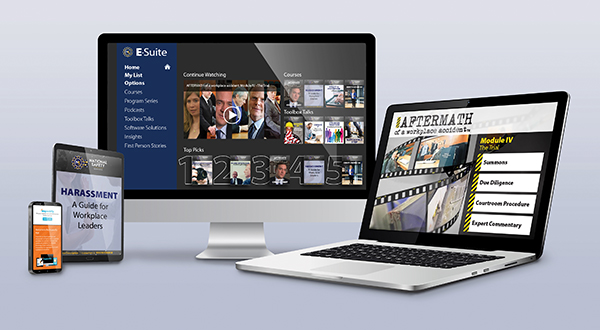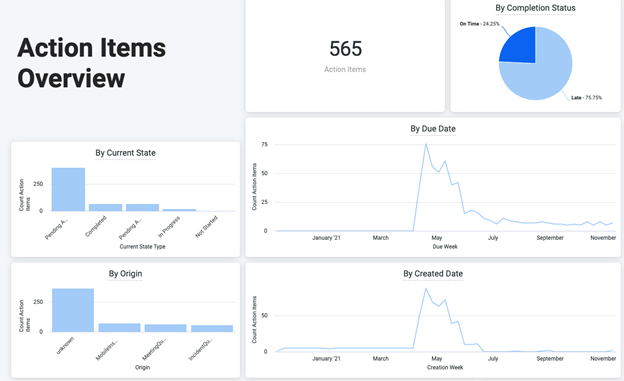
Safety solutions for the modern workplace
By Jack Burton
New training, technology, and protective measures are helping organizations conduct business with increased demands of safety

The need for dynamic, user-friendly software was the inspiration behind National Safety’s E-Suite. (Submitted Photos)
The past year and a half has pushed all definitions of a safe workplace into a state of constant flux, but helping employers stabilize and navigate these changes has been a whole new array of technology concerned with fulfilling the evolving health and safety needs of the workplace.
“Safety needs are very complex in our world because everything is interconnected and moving very quickly,” said Nicole Orr, co-founder and director of HSE risk management at National Safety in Edmonton, a new group comprised of safety strategists spanning provinces and industries.
“We don’t have time to develop in isolation anymore, so collaboration is crucial.”
When it comes to the new demands of safety gear and technology, Orr said that “hardware needs to be durable, portable, and often intrinsically safe,” while “software needs to be secure, able to integrate with other programs, and intuitive for the user.”
National Safety’s E-Suite: Safety training on the cutting edge
One specific challenge is educating employees on these new technologies and responsibilities at a pace matching current innovations.
“Getting people knowledgeable about process and systems is tricky now,” Orr said. “We need to use every possible advantage to get workers to get engaged and keep their attention. Those are tall orders, and trying to fill all those needs can be challenging.”
The need for dynamic and user-friendly software, along with current challenges around training and education, serve as some of the inspiration behind the development of National Safety’s E-Suite.
Set for the release in the first quarter of next year, the E-Suite is a comprehensive, multimedia training program that seeks to engage learners through cutting-edge use of graphics and editing technology lifted from the film and gaming industries.
“It’s really exciting for us, because it’s something that nobody else is really doing in this way,” said Orr.
“We have a studio that we will be developing various types of training through, with a full range of learning modalities. We’re talking about dynamic, engaging programming that’s completely outside the box, and that people will be excited to take in.”
Building a sense of excitement around workplace training — especially in areas such as personal safety and risk assessment, where proper training can literally be a life-or-death matter in some cases — is the main goal behind the E-Suite, and what National Safety hopes will establish a new standard in what both organizations and employees expect from their training programs.
To help achieve this, the E-Suite is taking cues from “extensive research on ways to engage people fully, so that the rate of retention through more active learning techniques gets them out of that training with a deeper understanding and retention of that information,” she said.
By placing user engagement and experience front and centre, Orr believes that employees “will have much higher retention of information, which is the whole point of health and safety training, and they will have much higher levels of engagement, motivation, and understanding related to the topic.”
3M: Getting smart about safety technology

3M’s DBI-Sala Nano-Lok Connected Extended Length Order Picker SRL Kit is an example of the company’s smart technology offerings.
Successfully confronting the changes to the workplace and the safety needs within has also required organizations to look toward advancements in other fields to incorporate into new innovations.
One company using emerging technologies to navigate these changing demands is 3M — it has employed current smart technology to add a digitally optimized and data-driven update to their roster of traditional safety offerings. This includes smart technology-enabled PPE that allows employers to track data regarding a number of actionable variables.
Of this change, Joe Hockett, global senior segment marketing manager of 3M’s personal safety division in St. Paul, Minn., said that “the rise and need for more data and analytics to help better manage, as well as try to predict and prevent future incidents, has driven the development of more connected safety devices.”
“This trend is likely to continue as smart devices become more common in all facets of life, and connected safety personal protective equipment is becoming part of this technology ecosystem,” he said.
Hockett explained the operational impact of these changes, highlighting that they “not only help train and educate, but also create data visibility to create better understanding on how products are being used and ensuring compliance.”
By equipping traditional safety equipment such as PPE with smart technology, the steps necessary to creating a safer workplace can become clear due to the increased flow of information that this technology makes available.
Some of these insights include “what changes to programs might be needed, if more training should be required, rates of compliance, when to make product changes, and opportunities to make improvements in all the above,” he said.

An analytic resource charting the path forward is Alcumus’ Safety Intelligence technology.
Alcumus’ Safety Intelligence: Connecting the dots of workplace safety
With information and data emerging as a major influence behind workplace safety’s current evolution, Alcumus aims to build technological solutions that use the tools offered by information in a way that “connects people, processes, and data globally to digitize and deliver transformational environment, health and safety (EHS) and environmental, social and governance (ESG) strategies that create safer, healthier, and more responsible organizations,” said their senior product marketing manager, Ryan Demelo, in Toronto.
One of the analytic resources charting this path forward is Alcumus’ Safety Intelligence technology.
Demelo explained that “Safety Intelligence is an advanced reporting and analytics solution revolutionizing how organizations leverage environmental, health and safety data to mitigate risks, demonstrate compliance, and reduce workplace injuries.”
Safety Intelligence’s “out-of-the-box dashboards and visualizations make it easy for organizations to adopt advanced reporting and analytics from Day 1,” he said, with this technology tracking and building a repository of information across a variety of fields such as a workplace’s compliance rates, key performance indicators, and internal safety trends.
This information provides employers with a “bird’s-eye view” of safety indicators and engagement rates that Demelo sees aiding them in building stronger accountability and understanding of their own safety programs, achieved by enabling them to “ingest and aggregate data from multiple sources to give a holistic view of performance, and shift to proactive EHS and ESG
strategies.”
Jack Burton is a freelance writer in Toronto.